Safe aurora tours: Thinking of a visit to Norway? Marianne's Heaven on Earth Aurora Tours has a 7-seater minivan for families who don't require social distancing. See the Northern Lights or take a scenic day tour. Book here | | |
SOLAR CYCLE UPDATE: Solar Minimum is here, and it's a deep one--a century-class lull in solar activity. At the same time, the next solar cycle is showing signs of life. A recent profusion of reversed-polarity sunspots, plus a big solar flare in May, herald the coming of Solar Cycle 25. Despite the recent quiet, Solar Maximum could be only a few years away. FULL STORY.
A SURPRISE VISIT FROM STEVE: Even STEVE wants to see Comet NEOWISE. On July 14th, the geomagnetic phenomenon appeared over Canada, streaking the sky with mauve ribbons of light. Harlan Thomas of Calgary, Alberta, reports: "I was out shooting the comet when I noticed a mauve-looking cloud. Wow!" I thought. "STEVE has come to visit NEOWISE. How cool is that?"
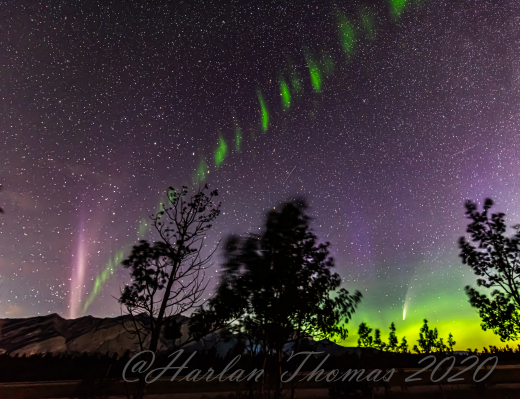
STEVE is a recent discovery. It looks like an aurora, but it is not. The purple glow is caused by hot (3000°C) ribbons of gas flowing through Earth's magnetosphere at speeds exceeding 6 km/s (13,000 mph). It appears during some geomagnetic storms, often alongside a type of green aurora known as the "picket fence," also shown in Thomas's photo.
Statistics suggest that STEVE appears most often in spring and fall. What summoned STEVE in mid-summer? It may have been a CME that grazed Earth's magnetic field on July 13th. As our planet passed through the CME's magnetized wake on July 14th, hot currents and plasma waves rippled through Earth's magnetosphere. STEVE was the result.
Christy Turner saw it too:
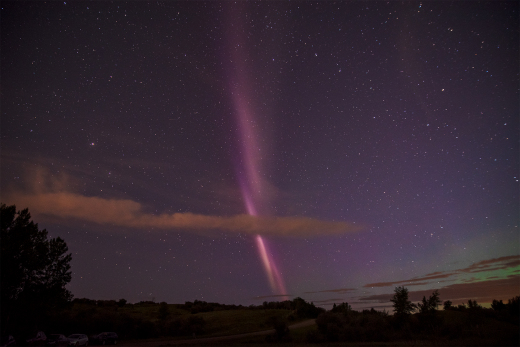
"I was shooting the comet outside Calgary when STEVE started to form," she says. "It was a huge purple pillar--a total delight!"
Many observers across western Canada witnessed the display. During a normal summer, STEVE might have been overlooked, but with Comet NEOWISE drawing photographers outdoors, his visit was well documented. "Summertime STEVE" might be more common than previously thought.
Realtime STEVE Photo Gallery
Free: Spaceweather.com Newsletter
COMET NEOWISE, HALE-BOPP'S "MINI-ME": Comet NEOWISE (C/2020 F3) may not be a Great Comet--but it certainly resembles one. "It looks like a clone of Comet Hale-Bopp," says Alan Dyer of Alberta, Canada, who sends this picture from Dinosaur Provincial Park:
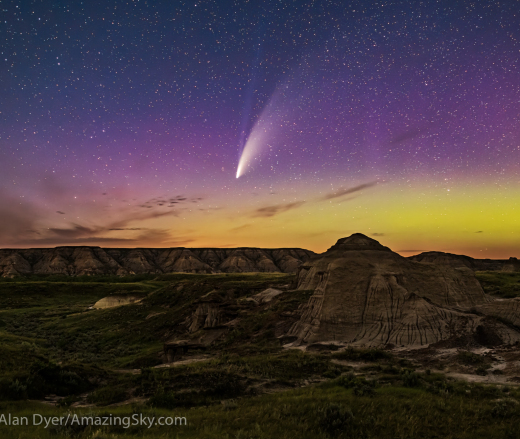
"We've had a marvelous couple of nights in Alberta with Comet NEOWISE in the sky alongside auroras and noctilucent clouds," he says. "The comet's ion tail is easily 15° to 20° long in images, while the dust tail is at least 12° long."
To see why Comet NEOWISE reminds observers of the Great Comet of 1997, just look at this 23-year-old picture of Comet Hale-Bopp. The two comets are doppelgangers. However, NEOWISE is more of a "Mini-Me" than a true clone. Comet Hale-Bopp was bigger and brighter, with tails twice as long as those of NEOWISE, and an icy nucleus more than 10 times wider than NEOWISE's.
Comet NEOWISE will be closest to Earth on July 23rd. Between now and then, you can find the comet in the sunset sky approaching the Big Dipper from below. It is visible to the naked-eye from dark sky sites and extra-beautiful through binoculars. Sky maps: July 15, 16, 17.
Realtime Comet NEOWISE Photo Gallery
Free: Spaceweather.com Newsletter
NORTHERN LIGHTS PENDANT: Nothing says "I Love You" like a Northern Lights pendant from the Arctic stratosphere. On Jan. 22, 2020, the students of Earth to Sky Calculus traveled to northern Sweden and launched a cosmic ray balloon. This pendant hitched a ride, floating more than 75,000 feet above the frozen terrain of the Arctic Circle:
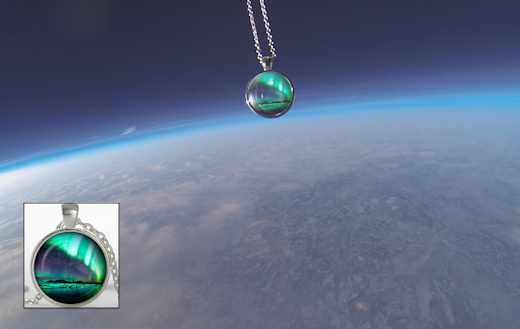
You can have it for $139.95. The students are selling these pendants to support their cosmic ray ballooning program. Each one comes with a greeting card showing the pendant in flight and telling the story of its journey to the edge of space and back again. They make great birthday and anniversary gifts.
Far Out Gifts: Earth to Sky Store
All sales support hands-on STEM education
Realtime Noctilucent Cloud Photo Gallery
Free: Spaceweather.com Newsletter
Every night, a network of
NASA all-sky cameras scans the skies above the United States for meteoritic fireballs. Automated software maintained by NASA's Meteoroid Environment Office calculates their orbits, velocity, penetration depth in Earth's atmosphere and many other characteristics. Daily results are presented here on Spaceweather.com.
On July 16, 2020, the network reported 22 fireballs.
(22 sporadics)
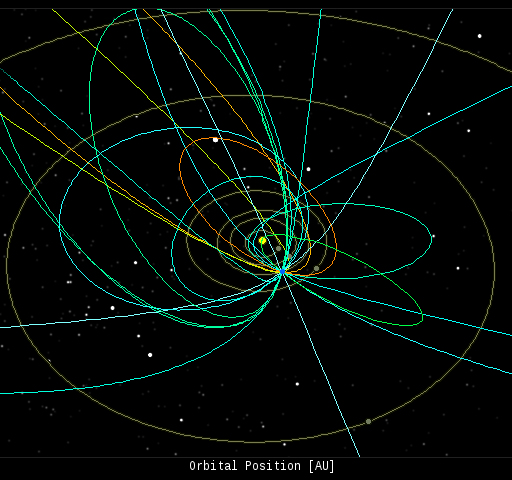
In this diagram of the inner solar system, all of the fireball orbits intersect at a single point--Earth. The orbits are color-coded by velocity, from slow (red) to fast (blue). [Larger image] [movies]
Potentially Hazardous Asteroids (
PHAs) are space rocks larger than approximately 100m that can come closer to Earth than 0.05 AU. None of the known PHAs is on a collision course with our planet, although astronomers are finding
new ones all the time.
On July 16, 2020 there were 2037 potentially hazardous asteroids.
 |
Recent & Upcoming Earth-asteroid encounters: | Asteroid | Date(UT) | Miss Distance | Velocity (km/s) | Diameter (m) |
| 2020 MU1 | 2020-Jul-11 | 18.8 LD | 2.7 | 38 |
| 2020 ML | 2020-Jul-12 | 11.4 LD | 4.4 | 23 |
| 2020 KJ7 | 2020-Jul-13 | 11.8 LD | 3.4 | 33 |
| 2009 OS5 | 2020-Jul-13 | 17.6 LD | 2.6 | 45 |
| 2020 MQ2 | 2020-Jul-14 | 17.1 LD | 8.3 | 44 |
| 2020 NM | 2020-Jul-16 | 10.6 LD | 5.7 | 20 |
| 2020 MX | 2020-Jul-17 | 15 LD | 5.3 | 50 |
| 2016 DY30 | 2020-Jul-19 | 9 LD | 15.1 | 3 |
| 2020 ME3 | 2020-Jul-19 | 14.8 LD | 4.6 | 24 |
| 2002 BF25 | 2020-Jul-21 | 9.4 LD | 6.8 | 129 |
| 2020 NO | 2020-Jul-22 | 2.1 LD | 7.7 | 15 |
| 2020 ND | 2020-Jul-24 | 14.5 LD | 13.6 | 169 |
| 2020 NN | 2020-Jul-25 | 16.3 LD | 10.1 | 47 |
| 2020 NZ | 2020-Jul-28 | 8.3 LD | 7.8 | 29 |
| 2020 MX3 | 2020-Jul-29 | 9.4 LD | 8.5 | 68 |
| 2018 PY7 | 2020-Jul-31 | 8.9 LD | 9.5 | 16 |
| 2007 RF1 | 2020-Jul-31 | 10.7 LD | 5 | 21 |
| 2018 BD | 2020-Aug-03 | 7.6 LD | 9.4 | 3 |
| 2009 PQ1 | 2020-Aug-05 | 10.8 LD | 13.5 | 112 |
| 2020 FA1 | 2020-Aug-23 | 18.4 LD | 1.9 | 20 |
| 2016 AH164 | 2020-Aug-26 | 15.7 LD | 5.6 | 4 |
| 2011 ES4 | 2020-Sep-01 | 0.3 LD | 8.2 | 30 |
| 465824 | 2020-Sep-06 | 19.4 LD | 14 | 162 |
| 2012 RM15 | 2020-Sep-12 | 14.9 LD | 9.8 | 45 |
| 2017 US | 2020-Sep-13 | 17.3 LD | 5.9 | 21 |
Notes: LD means "Lunar Distance." 1 LD = 384,401 km, the distance between Earth and the Moon. 1 LD also equals 0.00256 AU. MAG is the visual magnitude of the asteroid on the date of closest approach. | | Cosmic Rays in the Atmosphere |
SOMETHING NEW! We have developed a new predictive model of aviation radiation. It's called E-RAD--short for Empirical RADiation model. We are constantly flying radiation sensors onboard airplanes over the US and and around the world, so far collecting more than 22,000 gps-tagged radiation measurements. Using this unique dataset, we can predict the dosage on any flight over the USA with an error no worse than 15%.
E-RAD lets us do something new: Every day we monitor approximately 1400 flights criss-crossing the 10 busiest routes in the continental USA. Typically, this includes more than 80,000 passengers per day. E-RAD calculates the radiation exposure for every single flight.
The Hot Flights Table is a daily summary of these calculations. It shows the 5 charter flights with the highest dose rates; the 5 commercial flights with the highest dose rates; 5 commercial flights with near-average dose rates; and the 5 commercial flights with the lowest dose rates. Passengers typically experience dose rates that are 20 to 70 times higher than natural radiation at sea level.
To measure radiation on airplanes, we use the same sensors we fly to the stratosphere onboard Earth to Sky Calculus cosmic ray balloons: neutron bubble chambers and X-ray/gamma-ray Geiger tubes sensitive to energies between 10 keV and 20 MeV. These energies span the range of medical X-ray machines and airport security scanners.
Column definitions: (1) The flight number; (2) The maximum dose rate during the flight, expressed in units of natural radiation at sea level; (3) The maximum altitude of the plane in feet above sea level; (4) Departure city; (5) Arrival city; (6) Duration of the flight.
SPACE WEATHER BALLOON DATA: Approximately once a week, Spaceweather.com and the students of Earth to Sky Calculus fly space weather balloons to the stratosphere over California. These balloons are equipped with radiation sensors that detect cosmic rays, a surprisingly "down to Earth" form of space weather. Cosmic rays can seed clouds, trigger lightning, and penetrate commercial airplanes. Furthermore, there are studies ( #1, #2, #3, #4) linking cosmic rays with cardiac arrhythmias and sudden cardiac death in the general population. Our latest measurements show that cosmic rays are intensifying, with an increase of more than 18% since 2015:

The data points in the graph above correspond to the peak of the Regener-Pfotzer maximum, which lies about 67,000 feet above central California. When cosmic rays crash into Earth's atmosphere, they produce a spray of secondary particles that is most intense at the entrance to the stratosphere. Physicists Eric Reneger and Georg Pfotzer discovered the maximum using balloons in the 1930s and it is what we are measuring today.
En route to the stratosphere, our sensors also pass through aviation altitudes:

In this plot, dose rates are expessed as multiples of sea level. For instance, we see that boarding a plane that flies at 25,000 feet exposes passengers to dose rates ~10x higher than sea level. At 40,000 feet, the multiplier is closer to 50x.
The radiation sensors onboard our helium balloons detect X-rays and gamma-rays in the energy range 10 keV to 20 MeV. These energies span the range of medical X-ray machines and airport security scanners.
Why are cosmic rays intensifying? The main reason is the sun. Solar storm clouds such as coronal mass ejections (CMEs) sweep aside cosmic rays when they pass by Earth. During Solar Maximum, CMEs are abundant and cosmic rays are held at bay. Now, however, the solar cycle is swinging toward Solar Minimum, allowing cosmic rays to return. Another reason could be the weakening of Earth's magnetic field, which helps protect us from deep-space radiation.
| | The official U.S. government space weather bureau |
| | The first place to look for information about sundogs, pillars, rainbows and related phenomena. |
| | Researchers call it a "Hubble for the sun." SDO is the most advanced solar observatory ever. |
| | 3D views of the sun from NASA's Solar and Terrestrial Relations Observatory |
| | Realtime and archival images of the Sun from SOHO. |
| | from the NOAA Space Environment Center |
| | fun to read, but should be taken with a grain of salt! Forecasts looking ahead more than a few days are often wrong. |
| | from the NOAA Space Environment Center |
| | the underlying science of space weather |
 | To find reviews of new online casino sites in the UK try The Casino DB where there are hundreds of online casino reviews complete with bonuses and ratings. Get a bonus when playing at a new casino in the UK. The Genie got you covered! Looking for a new online casino? Try Casimpo the new site dedicated to making online casino simple, or check out the new Avenger Slots Casino and Slot Strike Casino Sites with over 500 online slots and casino games. . |
| | These links help Spaceweather.com stay online. Thank you to our supporters! |
| | | | | | |

